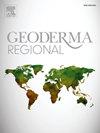Influences of fluvial and aeolian processes on palaeosols formation in Privlaka, Croatia
IF 3.3
2区 农林科学
Q2 SOIL SCIENCE
引用次数: 0
Abstract
The study was carried out on the pedo-sedimentary complex in Croatia's coastal region to describe the palaeosols' pedological, micromorphological and mineralogical properties and compare them with the recent soils. The field investigations comprised the definition, description and sampling horizons of an 8 m thick sequence of glacio-fluvial deposits, palaeosols and recent soils. Besides the field description and analyses of physico-chemical soil properties, the mineralogical composition was determined by XRD and soil thin sections were studied with a polarising microscope. The palaeosols are predominantly reddish in colour and have a considerable amount of carbonate concretions and rhizoconcretions, whereas the recent soils are brownish and without secondary carbonates. Large cracks filled with sandier material at the bottom of the sequence. The palaeosols are characterised by a higher percentage of sand particles and a lower percentage of silt particles than the recent soil. The recent soil has higher pH values and SOC contents, and lower CaCO3 contents than the palaeosols. The mineralogical composition of the palaeosols and the recent soil consists of quartz and calcite with feldspars (K-feldspar and plagioclase), goethite and clay minerals (kaolinite and mica). They differ in the presence of chlorite, which was recorded only in the recent soil, while Ti- and Mn-oxides, and Ch-hydroxides were only found in the palaeosols. The micromorphology does not show any glacial nor periglacial features, but a reddish recarbonated groundmass in the palaeosols and signs of clay illuviation inside some of the coarse fragments (quarztites), indicating that they are formed by pedosediments of terra rossa from the Dinaric Alps. The results show that the original decarbonated and rubefacted material was subjected to recarbonation by mixing with underlying limestones and by younger carbonated materials deposited on top, probably under arid conditions generating deep fissures. These processes agree with the formation of terra rossa under a warm and humid climate in which stable minerals (kaolinite, Fe- and Mn- oxides and hydroxides) predominate in the sediments under oxidating conditions. In contrast to the palaeosols, the recent soil has a mineral composition that is more typical of a climate with cold, dry winters and warm, humid summers.
克罗地亚普里维拉卡河流和风成过程对古土壤形成的影响
这项研究是对克罗地亚沿海地区的土壤-沉积复合体进行的,目的是描述古土壤的土壤学、微形态学和矿物学特性,并将它们与最近的土壤进行比较。实地调查包括对8米厚的冰川-河流沉积物、古土壤和近期土壤序列的定义、描述和采样范围。除现场描述和土壤理化性质分析外,用XRD测定了土壤矿物组成,用偏光显微镜对土壤薄片进行了研究。古土壤主要是红色的,有相当数量的碳酸盐结块和根结,而最近的土壤是棕色的,没有次生碳酸盐。序列底部的大裂缝充满了砂质材料。与近代土壤相比,古土壤的特点是砂粒百分比较高,粉粒百分比较低。近期土壤pH值和有机碳含量高于古土壤,CaCO3含量低于古土壤。古土壤和近代土壤的矿物组成由石英、方解石、长石(钾长石和斜长石)、针铁矿和粘土矿物(高岭石和云母)组成。它们的不同之处在于绿泥石的存在,绿泥石只在最近的土壤中被记录下来,而钛和锰的氧化物以及ch - oh只在古土壤中被发现。微观形态没有显示任何冰川或冰缘特征,但古土壤中有红色的重碳化地块,一些粗糙碎片(石英岩)中有粘土照射的迹象,表明它们是由第纳尔阿尔卑斯山脉的红土土的土壤沉积物形成的。结果表明,原始脱碳和变形的物质与下伏的石灰岩和沉积在顶部的较年轻的碳化物质混合,可能在干旱条件下产生深裂缝,从而再次碳化。这些过程与在温暖潮湿气候下形成的土相一致,在氧化条件下,稳定矿物(高岭石,铁和锰的氧化物和氢氧化物)在沉积物中占主导地位。与古土壤相比,近代土壤的矿物成分更符合冬季寒冷干燥、夏季温暖潮湿的气候。
本文章由计算机程序翻译,如有差异,请以英文原文为准。
求助全文
约1分钟内获得全文
求助全文
来源期刊

Geoderma Regional
Agricultural and Biological Sciences-Soil Science
CiteScore
6.10
自引率
7.30%
发文量
122
审稿时长
76 days
期刊介绍:
Global issues require studies and solutions on national and regional levels. Geoderma Regional focuses on studies that increase understanding and advance our scientific knowledge of soils in all regions of the world. The journal embraces every aspect of soil science and welcomes reviews of regional progress.
 求助内容:
求助内容: 应助结果提醒方式:
应助结果提醒方式:


